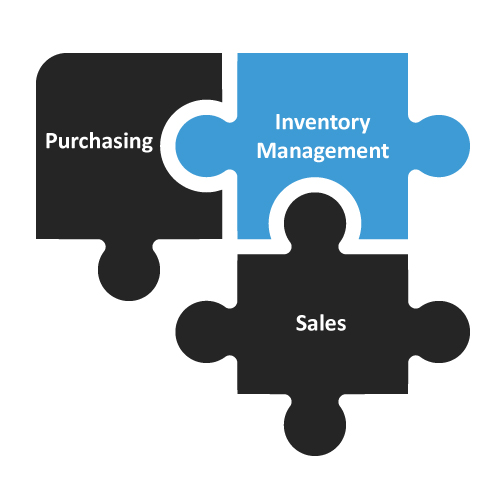Significance of Inventory Management
Built For


The significance of inventory management
Businesses and their processes have come a long way since traditional mom-and-pop shops were established; now, modern small and medium-sized businesses have evolved into competitive counterparts to the larger big-box retailers and chain stores through the use of technology.
Technology’s relationship to the significance of inventory management
Technology has also created some interesting opportunities — and challenges — for the modern business, those big and small. In Logistics Management’s Annual Warehouse and Distribution Center (DC) Operations Survey, three trends in the survey found that modern businesses dealt with:
- Increased e-Commerce and omnichannel sales; 6% more businesses added e-Commerce within the past year
- Increased number of SKUs; Average number up from 11,840 to 14,306
- Increased inventory turns


What’s interesting to note is that the increased number of SKUs and inventory turns were a result of increased e-Commerce and omnichannel involvement. Just as it appears that technology has caused a potential challenge for businesses, emphasizing the significance of inventory management, technology has provided a solution. Don Derewecki, senior consultant for supply chain and logistics consulting firm, St. Onge Co., explains that…
The encouraging thing is that companies are getting things done by employing more technology… Today’s operations are well beyond the simple manual environments that many industry veterans started out with.”
Understanding the significance of inventory management
With the increase in e-Commerce and omnichannel sales, as well as a higher number of SKUs and inventory turns to manage, businesses must understand the significance of inventory management. Inventory management plays a critical role in the health of a business because sales, purchasing, and other areas of business are affected by inventory management — just as inventory management is dependent upon the smooth operation of sales, purchasing, etc. Each of these “pieces” of business are interconnected with the other areas.

The utilization of technology is important for inventory management

Pen and paper worked for the small businesses of decades past. Spreadsheets worked for the small businesses of decades past, too. But what works for the small and medium-size businesses of today when the inventory challenges include omnichannel/e-Commerce, thousands of SKUs, and high amounts of inventory processing?
Technology.
In fact, certain technology exists specifically for inventory management purposes — inventory management solutions. However, many inventory management solutions exist, and sifting through all the solutions on the market becomes a daunting task. With inventory management becoming increasingly important, finding the right solution to handle inventory management also becomes increasingly important.
Let’s review the inventory challenges facing modern businesses discussed above and what those challenges will require of an inventory management solution.
The significance of Inventory Management for solving today’s business challenges
Challenge: Increased e-Commerce and omnichannel sales
Requirement: An inventory management solution will need to be able to handle sales from multiple channels in an integrated manner.
Analysis: Many businesses receive orders from a variety of channels: phone, web store, Electronic Data Interchange (EDI), etc. In order to effectively manage inventory with sales coming from a variety of channels, the inventory management solution must be able to keep track of sales regardless of the channel.
A phone order that’s been entered in by a salesperson is just as important to see as an order that comes from the web store or an EDI transaction from a Big Box Retailer. If the inventory solution is able to effectively manage these channels, then inventory information is kept accurate, up-to-date, and easy to manage.
Challenge: Increased number of SKUs
Requirement: An inventory management solution will need the potential to store an unlimited number of products.
Analysis: A viable inventory management solution will accommodate for growth. Therefore, a solution should be able to handle a growing amount of customers, vendors, inventory, etc. Since your inventory database will grow as the number of products you carry expands, the solution should be able to adapt as your business grows its inventory.
Challenge: Increased inventory turns
Requirement: An inventory management solution will need to keep comprehensive and detailed inventory data.
Analysis: With increased inventory turns comes increased inventory data. When inventory turnover increases, the amount of information about the inventory sold, purchased, and kept on-hand also increases. However, the information will need to be as thorough as possible, especially if products need to be tracked for quality assurance or regulatory purposes. By having an inventory management solution that keeps detailed records, you are able to go back and look at specific product information, and even filter it by certain criteria such as by SKU, serial or lot number, etc.
The significance of inventory management for putting the pieces of the supply chain together
In review, an inventory management solution must be able to:
- Handle omnichannel sales
- Allow your business to have unlimited inventory data
- Keep detailed inventory information
Is there a solution that can accomplish these three critical inventory management requirements for small and medium-size businesses?
Yes — Acctivate QuickBooks Inventory Management Software.

Acctivate is equipped to:
- Handle sales from multiple channels seamlessly, including web stores and EDI.
- Have a virtually unlimited amount of products in its database.
- Store pertinent inventory data, such as lot and serial numbers.
- Provide reports in order to assist with inventory management.
In addition to these features, Acctivate is capable of much more, giving your business the solution it needs to effectively tackle the modern-day supply chain challenges. Some of the other valuable inventory features Acctivate provides include:
Call us at 817-870-1311


